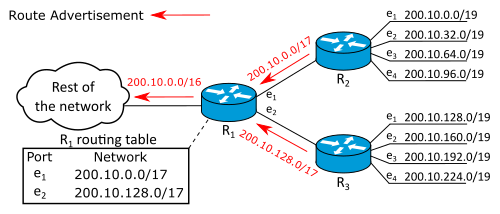
A supernetwork, or supernet, is an Internet Protocol (IP) network that is formed by aggregation of multiple networks (or subnets) into a larger network. The new routing prefix for the aggregate network represents the constituent networks in a single routing table entry. The process of forming a supernet is called supernetting, prefix aggregation, route aggregation, or route summarization.
Supernetting within the Internet serves as a strategy to avoid fragmentation of the IP address space by using a hierarchical allocation system that delegates control of segments of address space to regional Internet registries.[1] This method facilitates regional route aggregation.
The benefits of supernetting are efficiencies gained in routers in terms of memory storage of route information and processing overhead when matching routes. Supernetting, however, can introduce interoperability issues and other risks.[2]